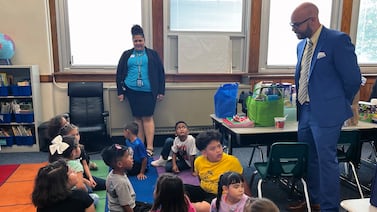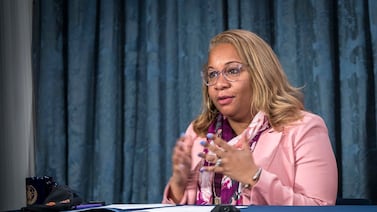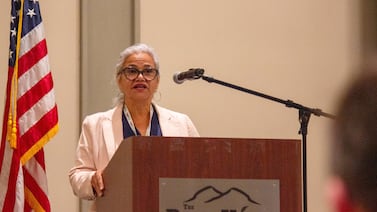Sign up for Chalkbeat New York’s free daily newsletter to keep up with NYC’s public schools.
A coalition of more than 100 New York organizations is urging the state to overhaul its nearly two-decade-old school funding formula.
The organizations, which previously joined forces to raise alarm over school programs that were put at-risk by the expiration of billions of dollars of federal pandemic stimulus funds, are now turning their attention to the state’s Foundation Aid formula.
In a joint statement, issued on Monday, they called for a revision to how the formula accounts for student poverty, added funding for students in temporary housing and the foster care system, increased support for students with disabilities and English language learners, and new funds for preschool students, as well as extra money to implement the state’s class size mandate for New York City schools, among other changes.
First implemented in 2007, the state’s formula is no longer sufficient to meet student needs, many education experts and politicians agree. As part of a state budget agreement earlier this year, the Rockefeller Institute is conducting a study on how to revise the formula, which sends roughly $24.9 billion to school districts — including more than $9.5 billion to New York City schools.
Though Foundation Aid just recently received full funding for the first time, it relies on decades-old data to calculate some metrics of district needs. Other factors, such as the number of students living in temporary housing, don’t weigh into the current formula at all.
“Gov. Hochul and the state legislature deserve a lot of credit for fully funding Foundation Aid,” said Randi Levine, policy director of the nonprofit group Advocates for Children, one of the organizations that signed onto the statement. “But the formula was developed more than 15 years ago … and doesn’t address the current needs of students and schools. We think the time has come to make changes to this outdated formula and ensure it reflects the needs of today’s students and schools, with particular attention to students who need the most support.”
Some question state’s approach to updating school funding formula
Advocates have also called for the state to overhaul the base model the formula uses to determine funding, arguing it isn’t responsive to the needs of large, urban districts like New York City. Known as the “successful school district model,” the base of the formula is currently calculated using the average per-pupil funding from a subset of school districts that perform well on standardized state exams.
As part of its study, the Rockefeller Institute held a series of public hearings over the summer to solicit testimony on the current formula, and has been tasked with issuing recommendations by Dec. 1.
But some have raised concerns over the state’s current approach to updating the formula, noting the Rockefeller Institute’s recommendations are not binding, and the budget agreement tasked the institute with developing a formula that is “fiscally sustainable for the state, local taxpayers, and school districts.”
“The key question should not be what is fiscally sustainable, but what our schools and students need to get a high quality education today,” Levine said. “This process could have major implications for students and schools in New York City and around the state, and it is essential that we get it right.”
Arlen Benjamin-Gomez, executive director of EdTrust-New York, added that the Rockefeller Institute has been given just months to conduct its study and issue recommendations.
“We are really concerned about the aggressive timeline, and that the stakeholder engagement was done at a time when folks just aren’t around,” she said. “I went to the New York City hearing and testified in front of a big, empty high school auditorium, because it was the middle of summer.”
During the last budget cycle, Hochul also introduced a tweak that adjusted how the formula accounts for inflation. That change led to the city missing out on roughly $120 million, though total state funding still increased for the year, according to city officials.
Though the city and state contributed roughly equal funding to New York City schools in the 2001-02 school year, advocates and city officials have noted that balance has shifted significantly in the two decades since. Today, the state contributes just over a third of the Education Department’s budget — meaning the city is shouldering a greater share of education spending, as overall costs have risen significantly over time.
Some of the changes the organizations are calling for echo suggestions voiced by the city’s Education Department. During the July hearing in Manhattan, schools Chancellor David Banks said the state should work to create a “more effective and equitable” school funding formula.
“Even with full funding, the Foundation Aid that we’re receiving has not kept pace,” Banks said, citing new challenges facing the city’s schools — including an influx of migrant students and expanded costs associated with services added over the past two decades, like 3-K and pre-K. “It is not nearly enough to support our students in the educational experience that they deserve.”
He called on the state to review the successful school district model, and to implement four specific changes: Providing funds for students in temporary housing and the foster care system, increasing weights for students with disabilities, updating regional cost calculations, and designating dollars to support the implementation of the state’s class size mandate.
Concerns over the formula are not unique to New York City, according to Marina Marcou-O’Malley, co-executive director of the Alliance for Quality Education, another group that signed onto the Monday statement.
“The same concerns exist in every school district in the state that we have talked to,” she said.
Marcou-O’Malley noted she was alarmed during last year’s budget cycle to see the governor discussing changes that would result in some districts receiving less funding, despite Hochul continuing to point to her administration fully funding Foundation Aid.
“You can’t have it both ways,” she said. “You’re either going to fully invest in education and sustain that, or you’re going to be cutting education.”
In total, more than 110 organizations signed onto the Monday statement calling for the formula to be overhauled.
“It’s rare in education that so many folks are so aligned,” Benjamin-Gomez said. “Everybody agrees that this formula is outdated and needs to be updated.”
Julian Shen-Berro is a reporter covering New York City. Contact him at jshen-berro@chalkbeat.org.






